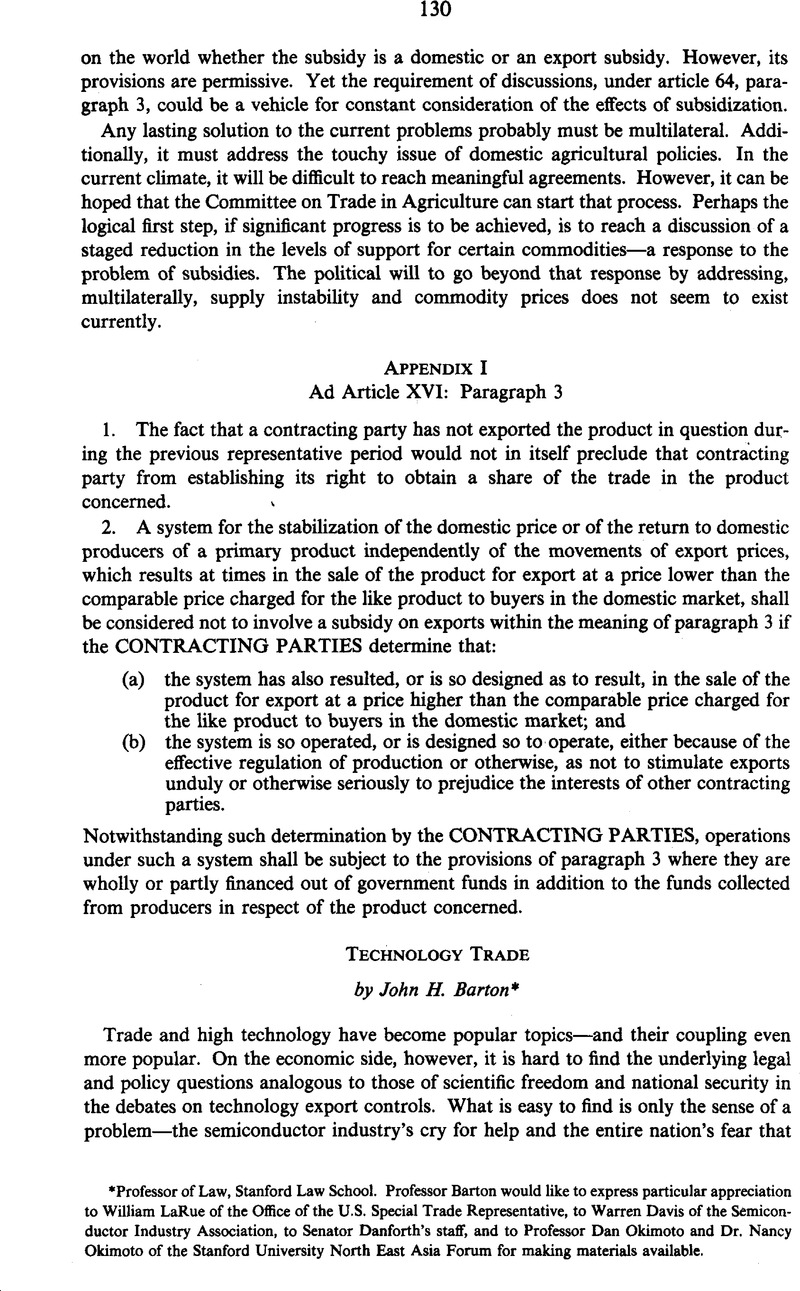Article contents
Abstract

- Type
- Fair and Unfair Trade in an Interventionist Era
- Information
- Copyright
- Copyright © American Society of International Law 1983
References
1 In 1962, the United States accounted for 28 percent of all Organization for Economic Cooperation and Development (OECD) exports of technology-intensive goods. In 1977, the corresponding market share was 19 percent. This reflected differential growth rates: 14 percent for U.S. technology-intensive exports (as compared with 11 percent for other U.S. exports) versus 17 percent for technology-intensive exports by all OECD nations. Data derived from Appendix Table 5 of C. Aho and H. Rosen, Trends in Technology- Intensive Trade: With Special Reference to U.S. Competitiveness, (Department of Labor), reprinted in Technology Trade: Joint Hearings Before the House Comm. on Science and Technology et al, 96th Cong., 2d Sess. 1980, 497, 573 (Serials 149, 96-197, 96-70, June 24, 25, 26, 1980) [hereinafter cited as Joint Hearings].
2 S. 144, 98th Cong., 1st Sess., [Proposed] Reciprocal Trade and Investment Act of 1982, § 5.
3 Trade in Services and Trade in High Technology Products, Hearings Before the Subcommittee on Trade of the House Committee on Ways and Means, at 16 (Serial 97-60, May 24, 1982) [hereinafter cited as Hearings].
4 GATT Study Proposal on Trade in High Technology Goods and Services, provided by William LaRue, Office of the U.S. Trade Representative.
5 Recommendations of the U.S.-Japan Work Group on High Technology Industries, ITA 83-, 2/10/83.
6 E.g., Krugman, Scale Economies, Product Differentiation, and the Pattern of Trade, 70 AM. ECON. REV. 950 (1980).
7 Id. See also the more empirical statement by William V. Rapp, Joint Hearings, supra n. 1 at 284, 288- 89.
8 Prepared statement of Charles E. Sporck on behalf of the Semiconductor Industry Association, Hearings, supra n. 3, at 129, 131.
9 As of 1977, the only nation whose exports of technology-intensive goods exceeded those of the United States was the FRG–which was also the only one whose R& expenditures as a percentage of GNP were even near those of the United States. Aho and Rosen, supra n.l, at 503, 573.
10 For a series of examples of technology support programs that may be somewhat out of date, but reflect the bewildering variety, see the chart and tables at OECD, 1 Policies For The Stimulation Of Industrial Innovation 56, 72-9, 127-37 (1978). See also, 3 Trade and Technology, Hearings Before the Subcommittee on International Finance of the Senate Committee on Banking, Housing, and Urban Affairs, 96th Cong., 2d Sess. 31 (January 15, 1980) (statement of Julian Gresser) (1957 Japanese "Electronic Industry Provisional Development Act") [hereinafter cited as Trade and Technology].
11 GATT Subsidies/Countervailing Duties Measures Code, articles 8.3, 11.1 and 11.2.
12 19 U.S.C. § 1677(5)(B).
13 Re Preliminary Countervailing Duty Determinations Concerning Certain Steel Products Originating in Belgium, 47 Fed. Reg. 39319 (1982).
14 Statement of David Macdonald, supra n. 3, at 16.
15 OECD, 2-1 policies for the stimulation of industrial innovation, 226-30 (1978).
16 Note the suggestions of Robert D. Schmidt (Control Data Corporation), Joint Hearings, supra n. 1 at 76, 100 ff.
17 For examples of the special versions of the high-technology area, see Statement of Robert Hormats, 3 Trade and Technology, supra n. 11 at 4, 6-8.
18 Convention for the Protection of Industrial Property, signed at Paris on 20 March 1883, as revised at Stockholm on 14 July 1967, 21 U.S.T. 1583, T.I.A.S. 6923.
l9 See, e.g., Zenith Radio Corp. v. Hazeltine Research, Inc., 395 U.S. 100 (1969). For examples of the various differences in restrictions on the provisions of patent licenses see Handler & Blechman, An American View of the Common Market's Proposed Group Exemption for Patent Licenses, 14 INT'L LAW. 403 (1980).
20 Statement of Barry MacTaggert (Pfizer International), Hearings, supra n. 3, at 120.
21 For a good discussion, see Graham, The Terms of Transfer of Technology to the Developing Nations: A Survey of the Major Issues, and Delorme, The Changing Legal Framework for Transferring Technology: Some Implications, in OECD, north/south technology transfer: the adjustments ahead: analytic studies, at 55 and 88, respectively (1982).
22 Eg., 19 U.S.C. § 1337A.
23 See Meadows, Japan Runs Into America Inc., fortune, Mar. 22, 1982, at 56.
24 Articles VIII. 1, 1.1(a).
25 35 U.S.C. §$ 204, 209(b) (Pub. L.No. 96-517 of December 12, 1980).
26 Making of the Precedent, far eastern econ. REV., Feb. 17, 1983, at 40.
27 See OECD, 2-1 Policies for the Stimulation of Industrial Innovation 221 (1978). Specialty Steel Industry of the United States, Review of Recent Developments; Foreign Subsidization of the Steel Industry with Emphasis on the Specialty Steel Sector, (March 31, 1979) reprinted in 1 Trade and Technology, Hearings Be/ore the Subcommittee on International Trade of the Senate Committee on Banking, Housing, and Urban Affairs, 96th. Cong., 1st Sess. 136 (Nov. 19, 1979) (organization of French steel industry).
28 See Testimony of Harold Malmgren, Joint Hearings, supra n. 17 at 464-65: Trade Reciprocity II, Hearings Before the Subcommittee on International Trade of the Senate Finance Committee, 97th Cong., 2d Sess. 137 (May 6, 1982) (testimony of W.J. Sanders, III on behalf of the Semiconductor Industry Association).
- 1
- Cited by


